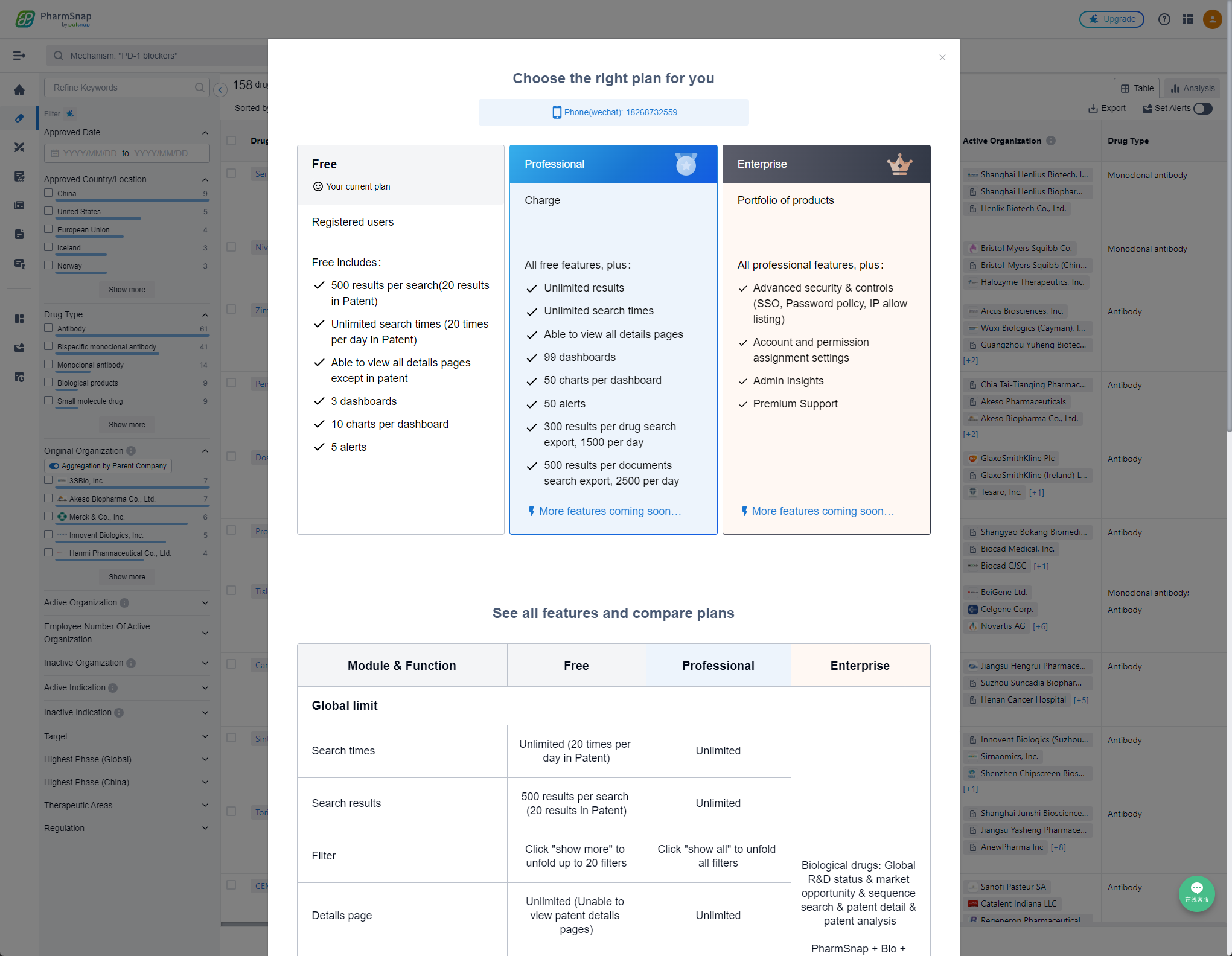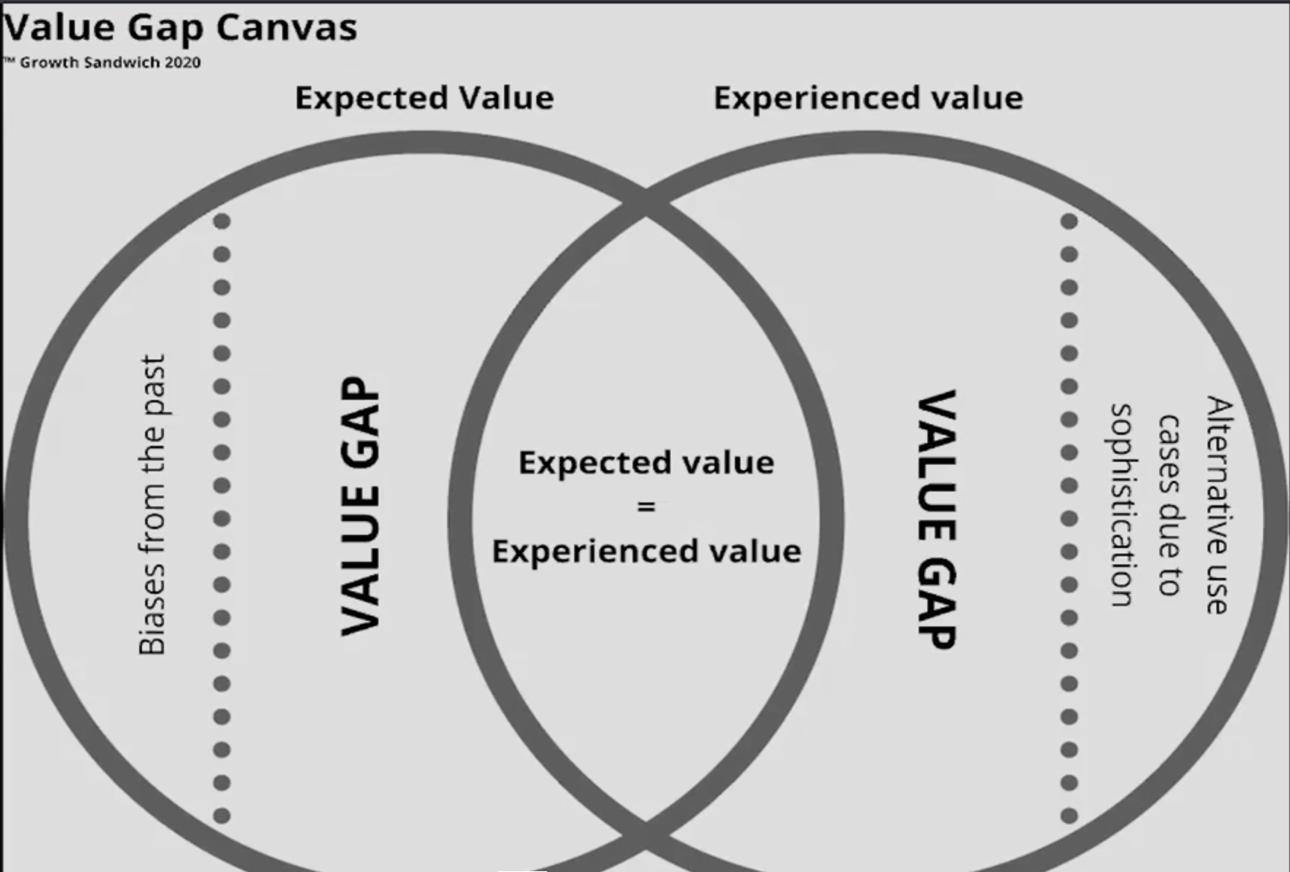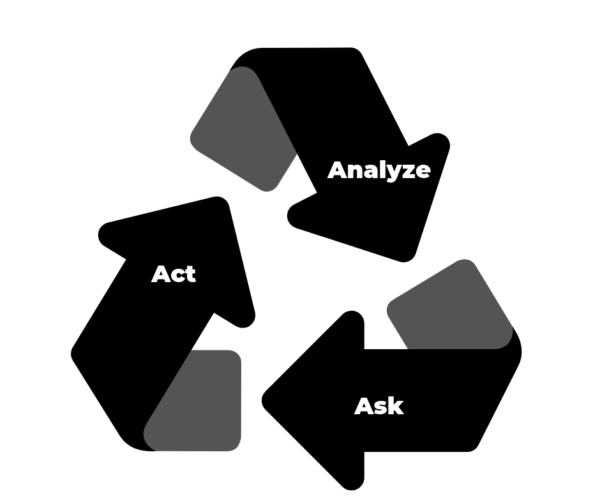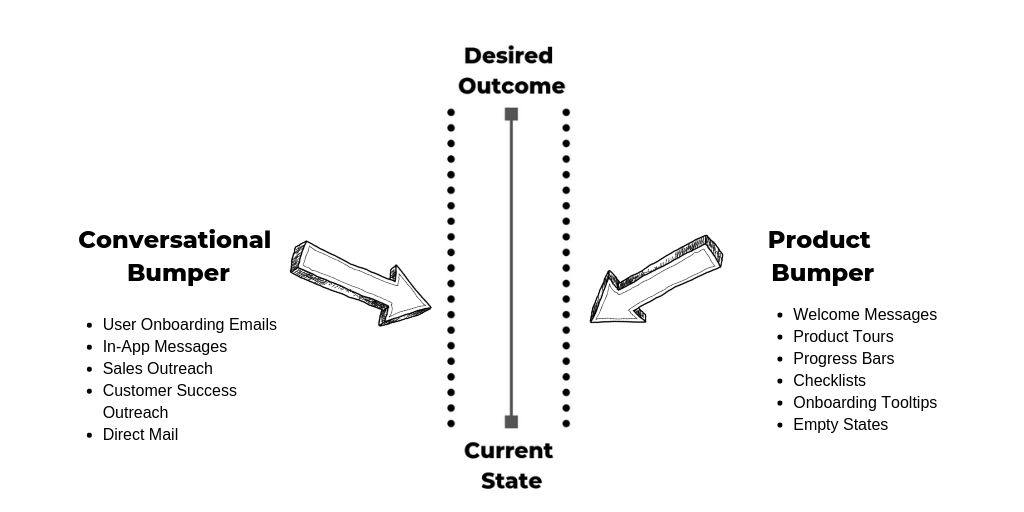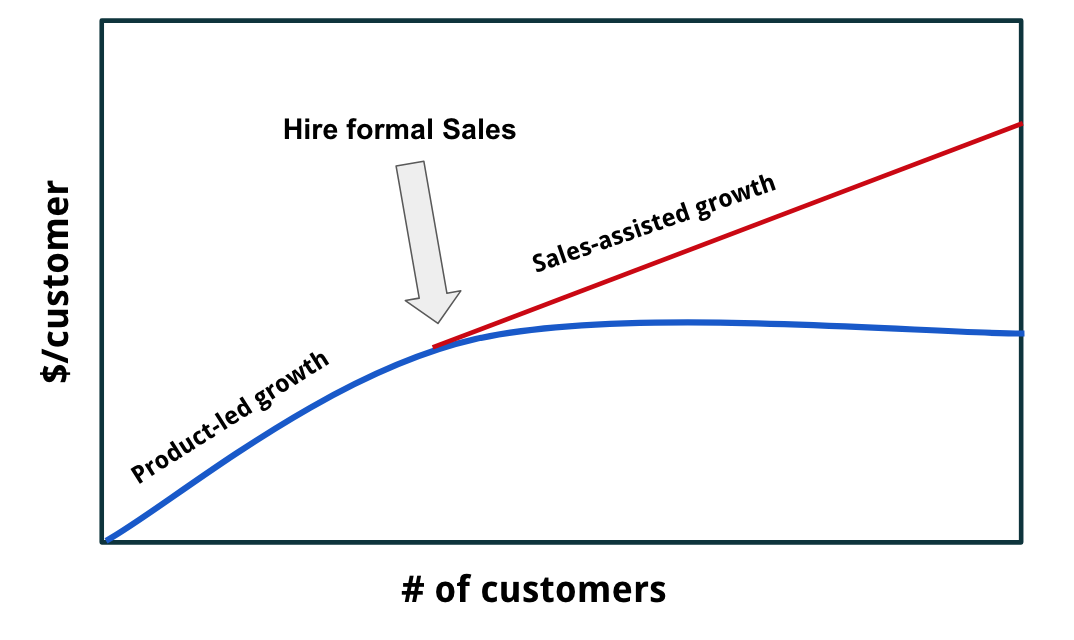Thoughts On PLG
Preface
As the development of the life-science industry around China and global, more and more requirements from drug manufacturers, bio-techs, they really need a platform which could speed up their decision-making process. For some historical reason, until now, most of the platforms in the world are under the TOB model. Customers don’t even know what the platform looks like before they decide to book a demo from sales rep. Under this situation, PLG should be a great way for decision makers in the life-science industry. By mentioning PLG, then you can’t ignore a person, Wes Bush, the founder of PLG institute, and his book PRODUCT - LED GROWTH which was published in 2019, and here are some key takeaways from this book.
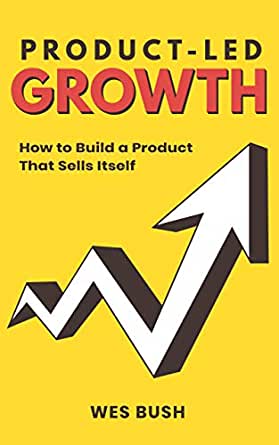
Disclaimer
This article is inspired by book PRODUCT-LED GROWTH, also, most of the concepts for PLG in this article comes from the book too, and this blog won’t be commercial used for any purpose, if you like PLG, please redirect to Product Led Growth or Wes Bush’s Twitter to check for more details.
For the company snapshot which been used in this blog, then I would love to proudly introduce my product - Discovery to you which perfectly match the need of R&D decision makers. For more information, please refer to Discovery
Outlines
Design Your Strategy
Why PLG
Before we get into PLG, first, let’s take a look into OpenView who coined PLG.

“OpenView is the leading VC investing in product-led growth. They bring a unique
perspective to their work with Calendly. Their network has also been impactful
to our success. Many of OpenView’s introductions have turned into advisors or
employees at Calendly.”
And from their investment industry distribution, it’s not a surprise to get that PLG is almost suitable for any digital market area, especially for SaaS tools .
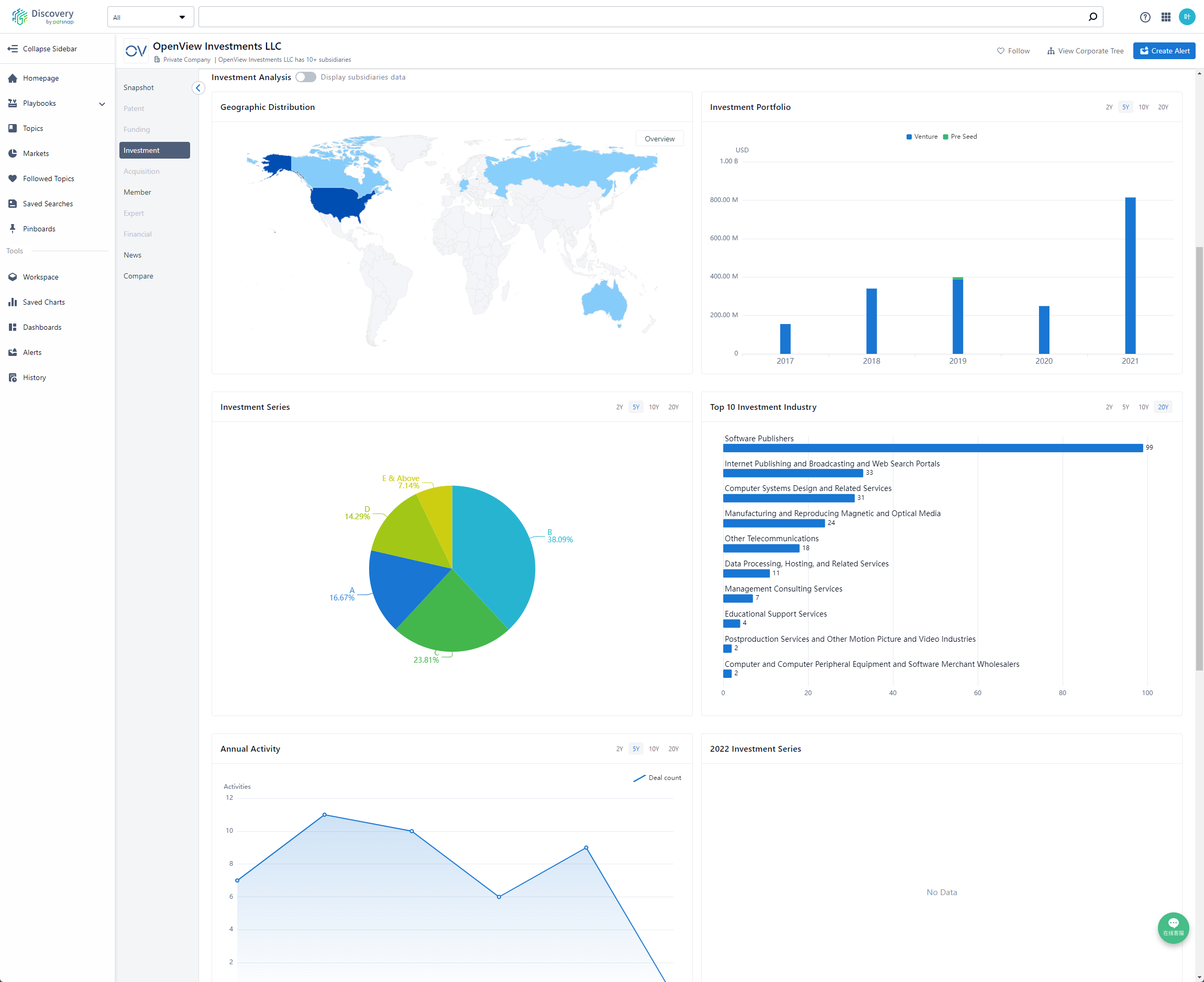
Here is an list from OpenView website, it reveal the top companies who are using PLG to boost their business.

From the book, Wes said Product-Led Growth is a go-to-market strategy that relies on using your product as the main vehicle to acquire, activate and retain customers.
As the SaaS industry evolves, there will be two types of companies,
- Sales-led companies represent the old way. It’s complex, unnecessary, expensive, and all about telling cinsumers how the product will benefit them. These companies want to take you from Point A to Point B in their sales cycle.
- Product-led companies flip the traditional sales model on its head. Instead of helping buyers go through a long, drawn-out sales cycle, they give the buyer the “keys” to their product. The company, in turn, focuses on helping the buyer improve their lif. Upgrading to a paid plan becomes a no-brainer.
Then we come to an important part which is there are three Tidal Waves coming for subscription business.
- Startups are more expensive to grow
- Buyer now are prefer to self-education
- Product experiences have become an essential part of the buying process
Won’t say Sales-led GTM strategy is totally useless, but somehow, under these situations, purely Sales-Led GTM strategy is at risk for SaaS business. Let’s check the Pros & Cons for Sales-Led.
- Ability to close high Lifetime Value(LTV) customers
- Perfect for hyper-niche solutions (In contrast, the Product-Led model is build for a large Total Addressable Market [TAM] where you can scale rapidly)
- Perfect for new categories
- If you jump too quickly to a product-led model with a new category, you risk a high churn rate because you simply don’t understand what it takes for customers to succeed.
-
High customer acquisition costs(CAC)
- The customer acquisition model is leaky
- It encourages marketers to gate content to hit their MQL goals
- It focuses on content consumption as a leading indicator of intent
- The entire process rewards creating friction in the buying process
- The organizational structure hinders great product development
- The problem with this organizational structure is that the product is often an afterthought.
PLG is not an easy-implementation strategy for GTM, you need to make sure that every team has a hand in helping each user become successful.
Pros:- Dominant growth engine
- Wider top-of-funnel
- Rapid global scale
- A significantly lower CAC
- Faster sales cycles
- High revenue-per-employee(RPE)
- If you try to double-size your revenue, more sales reps? Yes but no, SLG always has an limitation on RPE, can’t always rely on it.
- Better user experience
- At least, customers could Try Before They Buy
Free Trial, Freemium, or Demo
What works for those successful companies may be won’t necessarily work for you. At this point you need a decision framework to compare the free-trial, freemium, and demo trials. In the book, author introduce the MOAT framework which could help to pick the right GTM strategy.
- Market Strategy: Is your GTM strategy dominant, disruptive, or differentiated?
- Ocean Condition: Are you in a red -or blue-ocean business?
- Audience: Do you have a top-down or bottom-up marketing strategy?
- Time-to-value: How fast can you showcase value?
Remember this framework, it will be mentioned or explained for several times in the following chapters. Then back to the market strategy, free-trial, freemium and demo trial, now it might seem like freemium is just an indefinite free trial, but the GTM strategies could not be more different. Let’s put these three into a matrix which Charge Status in X axis, Gets Job Done for Y axis at same time, then see what kind of strategies that the book tell us and what’s the differences.
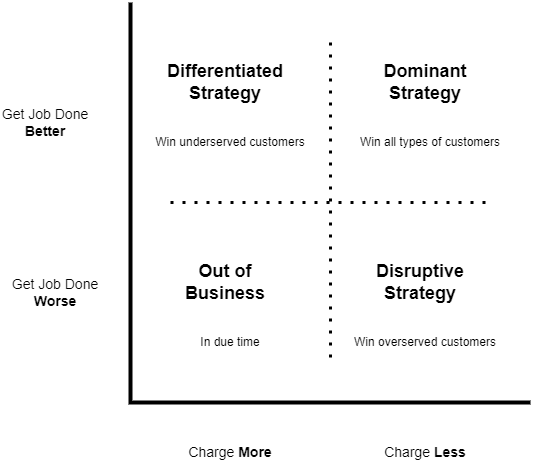
There are unique advantage for these 3 strategies, author structure them one by one as followed:
Dominant SaaS Growth Strategy
- Works great if you can do something much better than your market and can charge significantly less.
- The book tell us
Netflixis the one who take the dominant SaaS strategy, yes, it’s totally right before 2019, the lowest price around$9.99/monthfor basic plan, and nearly 4,000 films and 1,500 shows, no fierce opponents. As the development of the competitor such Hulu, Disney+, Amazon Prime, Netflix is about to remove free trial in UK and raise the price to$12.98/month. Now it’s market strategy more like a hybrid model which more nearby differential strategy.

- Both freemium and free-trial models works much better than the traditional sales model in the dominant growth strategy because you keep costs low and prevent competitors from stealing your market share. Freemium is vital in a dominant growth strategy and can help you take a sizeable chunk out of a market.
ElasticSearchis a good case for dominant strategy. Totally free for personal use or for light use for enterprise, great ecosystem, user-friendly, high performance etc. etc. etc. Now the market capitalization for ElasticSearch is around 8B and with a peak for 14B.
- The book tell us
So, the question before you take the actions:
- Is your TAM big enough to support a freemium model?
- If you are in a niche market, for example, only 50 stable customers as TAM, then forget about PLG.
- Does your product solve a specific job significantly better and at a lower cost than anyone else in the market?
- Can your user realize significant ongoing value quickly with little-to-no help from company personnel?
- Do you want to be the undisputed market leader in your category?
Differentiated SaaS Growth Strategy
- Try this strategy if you pick your fight with the industry goliath.
- For instance, a data search engine startup trying to survive the competition with a public company, then the startup should considerate the differentiated strategy. Focus on a market that the competitor not that urgent to touch and also doing better than the public company just in resolving customer’s problem who is in this niche market.
- This strategy requires you to do a specific job better than the competition and charge significantly more.
- Both free-trial and demos works great with a differentiated approach, but due to the TAM, a freemium model often will not work well in this environment.
So, the question before you take the actions:
- Is your market comprised of underserved customers?
- What is your TAM?
- Is your Annual Contract Value (ACV) high enough to support a low- or high-touch sales team?
- Could your prospects experience an “Aha!” moment during a free trial.
Disruptive SaaS Growth Strategy
- Require charge less for what many might consider an “inferior product”
- Compare to Adobe Photoshop, Canva, a online design tool which much easier to use, and really fit for those over-served customers who just want to create a social media graphics in seconds.

- The products which take disruptive SaaS growth strategy:
- Google Docs (Relative to Microsoft Word);
- Udacity (Relative to traditional universities);
- Wave (Relative to traditional accounting software);
- Since the product is a scaled-down version of an existing solution, it must be easy to use.
- Freemium model thrives in the disruptive environment. It keeps costs low for drawing in prospects by using existing solutions.
- Compare to Adobe Photoshop, Canva, a online design tool which much easier to use, and really fit for those over-served customers who just want to create a social media graphics in seconds.
So, the question before you take the actions:
- Is your market full of over-served customers?
- Are you competing in a hyper-competitive market?
- Is your market large enough to support a freemium model? (Hint: Look to your competitors to gauge the market size)
- Do you have the resources to support a freemium model?
- Can your onboarding be completely self-services?
Make The Decision
Now need you to make the decision on your growth strategy, questions to ask yourself when deciding on your market strategy:
- Do you want to offer the best solution for the lowest price? (Dominant strategy)
- Do you want to offer the best-customized solution for the highest price to underserved customers? (Differentiated strategy)
- Do you want to offer the simplest product for the lowest price to our-served customers? (Disruptive strategy)
- Or are you planning on using a hybrid strategy?
If you still hard to make your decision, here is an entrance for Testing Which Growth Model You Should Choose, you can answer same question at different stage, then the result may different. Also, beside free-trial and freemium, consider whether a hybrid model might work too.
Hybrid Model 1: Launch a new product
Launch a new product could let you experiment with PLG, build in-house expertise and vet if the model will work, but also, the most important thing is you could de-risk your business.
Hybrid Model 2: Go freemium, with a trial If you have a product with lots of features, this strategy can work well. Like HubSpot, you get immediate value from the product, but as you get more value from the free product, they tempt you with free-trial landing pages for blocked features. This allows the user to experience the new feature for a limited amount of time before upgrading.
Hybrid Model 3: Go free trial, follow with freemium
If user can’t convert until 7 days or 30 days free-trial passed, this may due to several reasons, like user do not have enough budget this year, or they are waiting until your product became more completely. Then you could prompt them using your freemium version at least, and keep your solution at the top their mind.

Red or Blue Ocean
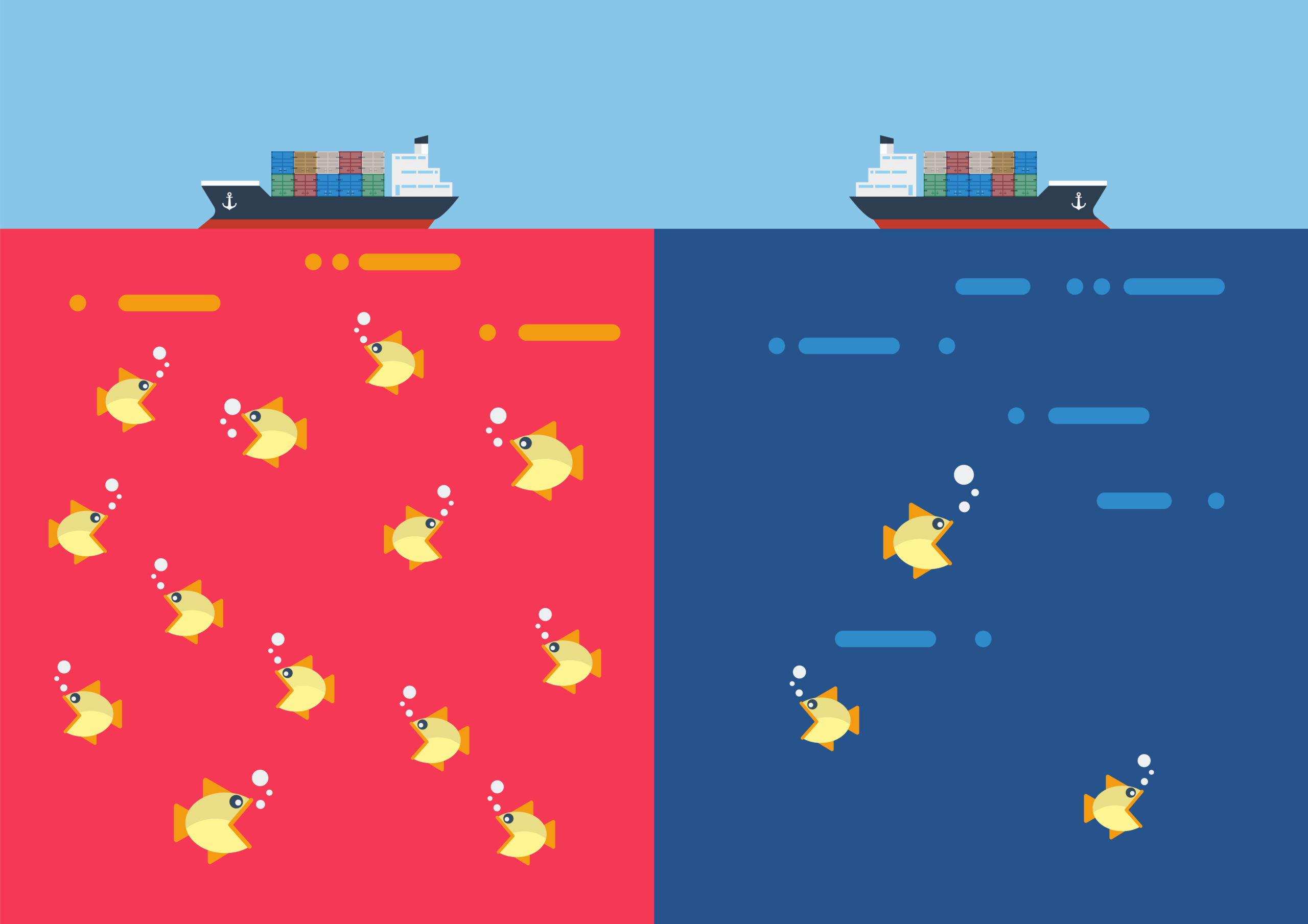 Before we dive into how your ocean strategy will affect your PLG model, let’s check the differences between Red-ocean and Blue-ocean.
Before we dive into how your ocean strategy will affect your PLG model, let’s check the differences between Red-ocean and Blue-ocean.
Red-ocean companies try to outperform their rivals to grab a greater share of existing demand. (Harvest Demand)
Blue-Ocean:Blue-ocean companies access untapped market space and create demand. (Create Demand)
PS: One thing should be noted that even in the same market, depends on what market segment you are focus on, the strategy for red-ocean or blue-ocean could be different. For instance which the book tells us that, BI is a bloody red-ocean, but you could just focus on SMB which is a blue-ocean in 2019.
Why dose this matter to PLG?
Depends on what kind of business you are doing, the strategy for blue-ocean could be different. For most of the time, leverage SLG is a good choice for blue-ocean, because blue-ocean mean your idea or concept is quite new to the end-users, the market is not that mature. You need to educate user and deliver your value to specific customer at first. Like sales-force at very beginning. However, we can’t deny, if your business is quick time-to-value, use PLG is also a great idea. For example your product is as simple as Spotify, everybody need it every day etc. SLG is the beginning but not the end, you need to ask “when” not “if” you’re going to launch a PLG arm of business.
In a red-ocean, market share, CAC is everything. You need to grow as fast and profitably as possible. PLG help you widen your funnel, decrease your CAC and help you expand globally in a fraction of time, also could convert “non-customers” - people who typically won’t reach out to request pricing or sign up for a demo request. However, these non-customers are willing to try your product if it’s in PLG model.
Questions to ask yourself when deciding between a blue or red ocean?
- Am I creating or capturing existing demand?
- Does the product have a quick time-to-value?
- Will a marketing, sales, or product-led GTM suit my business the best?
No matter which you select, there are a few things to keep in mind. First of all, it is important to remember that value creation and innovation are critical success factors. Also, remain aware of the industry that you are competing against as well as new introductions to the market that may disrupt any market share that you have attained
Top Down or Button Up
From audience prospective, to-down or button-up strategy are always be needed.
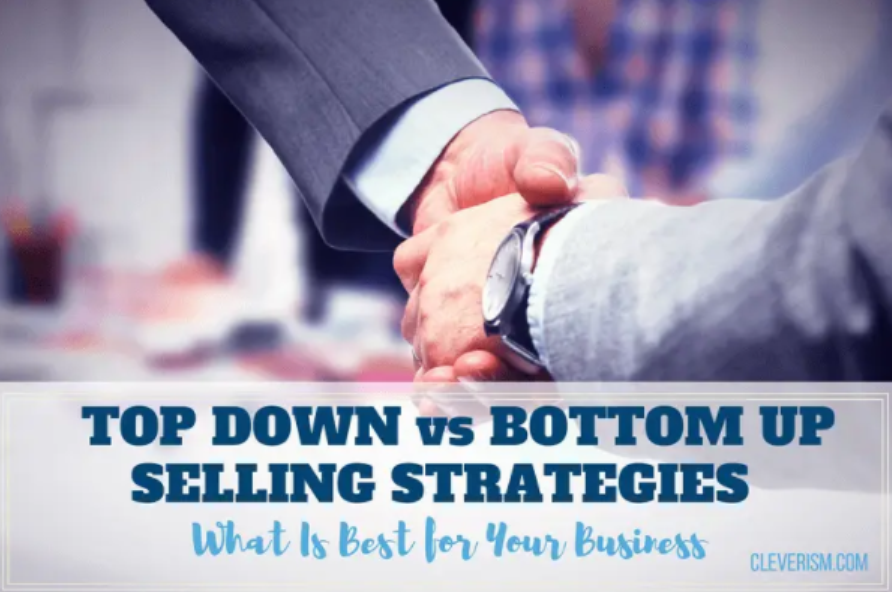 © Shutterstock.com | Micolas
© Shutterstock.com | Micolas
When using a top-down selling strategy, your sales team targets key decision-markers and executives, and one reason the top-down sales strategy exists is that business want uniformity. Decision makers like to keep their business organized and allocate resources efficiently. For instance, SAP, Oracle, IBM, the business they are making need them to reach out the key decision makers at very beginning, then convince internal teams to use for software is step 2.
Unlike the top-down selling strategy, where it may take months or years to close a sale, bottom-up selling strategies demand quick adoption and simplicity. A big reason to choose a PLG in bottom-up strategy is that if people can’t see the value in using your product quickly, fiw will upgrade.
Pros and Cons of top-down and bottom-up selling strategies.
- A top-down selling strategy pairs well with a sales-led go-to-market strategy
- A bottom-up selling strategy works almost exclusively with a product-led go-to-market strategy
Top-Down Selling Strategy
Pros:- High ACV
- Additional Services
- Low Customer Churn
- Poor revenue distribution
- High CAC
- Long Sales Cycles
Bottom-Up Selling Strategy
Pros:- Wider top-of-funnel
- Lower CAC
- Predictable sales figures
- Revenue Diversity
- Scale globally fast
- Fast sales cycles
- Contract size
- Non-paying customers
- Significant investments
- Expertise shortage
What selling strategy is right for you?
If your product has a freemium model and a top-down selling strategy, the two approaches will repel each other. However, if you align your product-led model with your selling strategy, you’ll have unmatchable synergy.
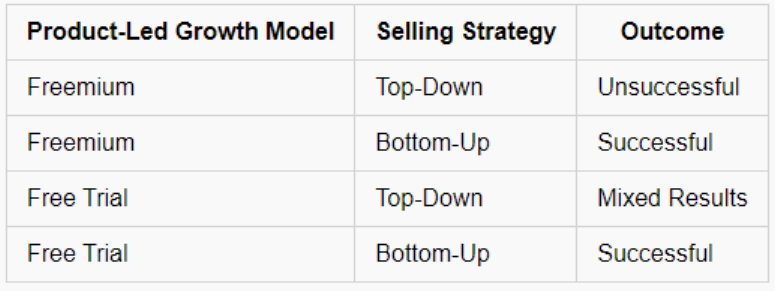
Two Important Takeaways
In Freemium and top-down selling, the freemium model rarely works with a top-down selling strategy for a few reasons. First, you’re expecting decision-makers and executives to understand how to use your product. Most decision-makers won’t be everyday users of the product, so it doesn’t make sense to onboard them in the first place. This is true and struck a chord with me as I am working in SaaS company for 6 years.
In Free trial and top-down selling, you should not be focus on short-term revenue at very beginning, keep the leads warm, well educate the decision-maker and end-user should be the first place otherwise failure comes.
Questions to ask yourself when deciding between a top-down or bottom-up selling strategy
- Are you currently targeting people who can easily use your product and experience its value?
- What is your ACV for each customer? Is it high enough to justify a low- or high-touch sales model?
Showcase value as fast as possible
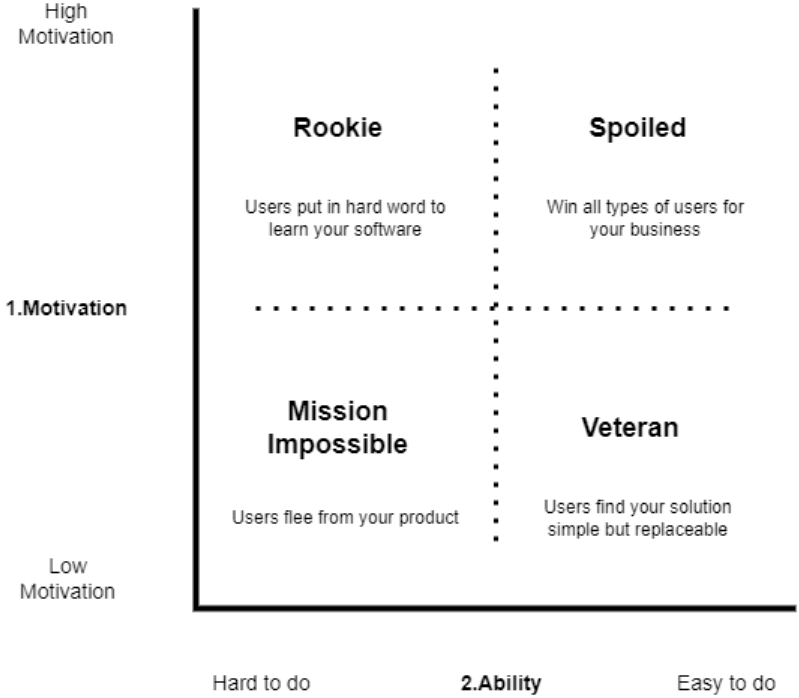
From the book, author show us the matrix as above, and back to the real world, the main principle for PLG is time-to-value as fast as possible. 40%-60% of users never come back after signing up. So, how do improve it?
Let’s analyze your existing users in four types:
-
Mission Impossible Users
Low motivation and also found your product really hard to use -
Rookie Users
High motivation and really want to try your product even if your product is hard to use -
Veteran Users
Low motivation, whatever how hard to use, they always could find the points but also they may flee at any time -
Spoiled Users
High motivation and also, found your product is perfect match their needs and easy to use
Now, ask yourself which user are you most familiar with? Also, try to think about the questions as below:
-
How motivated are users when they sign up for your product?
-
Is your product easy for your target audience to use?
-
Can users experience the core value of your product without hand-holding?
Last but not the least, always remember, eliminate unnecessary steps in your onboarding .
Build Your Foundation
Build PLG Foundation
Risk comes from not knowing what you're doing

PLG is a life raft that will save you from the flood of rising customer acquisition costs and decreasing willingness to pay for your product. In the book, WES show us a framework that could let us know how to build a solid foundation for your PLG.
- Understand your value
- Communicate the perceived value of your product.
- Deliver on what you promise
UDC framework is that you can apply it to any of these scenarios:
- You’re just launching a business and want to go down the product-led path.
- You’re starting a product-led arm of an existing company.
- You’re transitioning from a sales-led to a product-led business.
- You want to relaunch your product-led model because it’s currently under-performing.
Skip any step may raise the risk for delivering a mediocre experience to the user.
Understand Your Value
Whatever you agree or not, we are selling an outcome to acquire customers better. What outcome do people expect when they buy your product? Most technology companies get caught up in the features and don’t really know why people buy their product. So, they create blank headlines that read, “We sell XXX software for XXX support”. Boring and without any value. Why people choose your product over another?
"Cheating on customer development is like cheating on your parachute-packing class." It's not worth it.
The three reasons that people buy a product
-
Functional Outcome: the core tasks that customers want to get done This is the basic outcome that user need from your product. Like using Google Ads to acquire leads and using BI tool to understand the core KPI of the business.
-
Emotional Outcome: how customers want to feel or avoid feeling as a result of executing the core functional outcome Emotional outcome could be someone’s feeling after they using the product. For example, user feel empowered when they use Google Ads found a big leads etc.
-
Social Outcome: how customers want to be perceived by others by using your product For example you show a weekly leads report to your colleagues in fancy charts and structured data, and this makes you more professional in their eyes
If you can understand the three main outcomes behind why people buy your product and execute on it, you’re on the right track to building a strong product-led foundation. The challenge, however, is always in the execution. For instance, if your product offers video hosting but people sign up thinking that you’re a video marketing agency, they’re doomed from the start.

So, what’s the value metrics of your product? If you’re selling shoes, then your value metrics is ‘per pair of shoes’, if you’re running a video platform, the value metrics could be the number of videos uploaded and for communication application, the value metrics could be number of messages sent. Your value metrics play a vital role in how you price your product, set up your product metrics, and build your team.
What Makes a Good Value Metrics
- It’s easy for the customer to understand
- When someone visits your pricing page, will they immediately understand what they’re paying for and where they fit in your packaging?
- It’s align with the value that the customer receives in the product
- What core components lead someone to experience a meaningful outcomes?
- Grows with your customer’s usage of the value (Check more on OpenView website)
- Get more, charge more.
- User based or not? Think before you select per using pricing. The more of these conditions are true, the better per user pricing will work for your business.

- Usage based value metric has a better shot at reflecting the unique value perceived by customers for your specific product. For example, charge by the number of space, the widgets or content in each space etc.
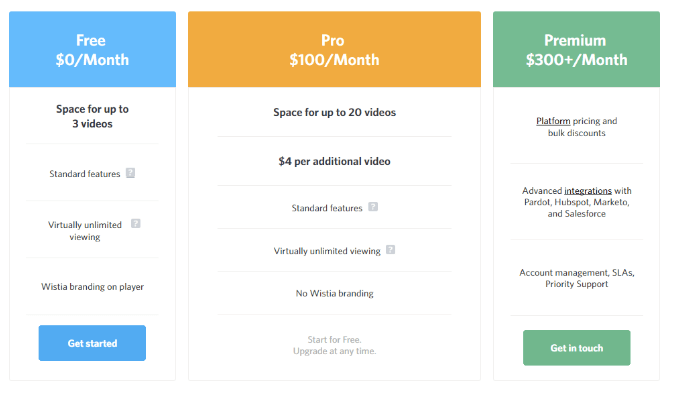
When you are in an early stage of your growth, you have tremendous flexibility to experiment with different value metrics and pricing structures.
How to find your value metric
-
Subjective Analysis

-
Data-Driven Approach
Classify user intoChurn Quickly,Barely Use,Power UserandUser with High Lifetime Value, and ask yourself when analyzing your data:- For best customers
- What do my best customers do regularly in the product?
- What do my best customers not do in the product?
- What features did my best users try first during onboarding?
- What similarities among my best users that led to success? demographics? team structure or ability?
- For churned customers
- What were some of the main differences between their user journey and that of your best customers?
- Specifically, what activities were different? What outcomes did your churned users achieve and not achieve?
- Were these churned customers in your target market?
- Why did the majority of these customers churn?
- For best customers
Once we know the answers and collect them together, abstract these into the value metrics, then you could know what kinds of users you could serve and what’s the value metrics is well-fitted for them. This could be different value metrics for different users in different products.
Communicate Your Value
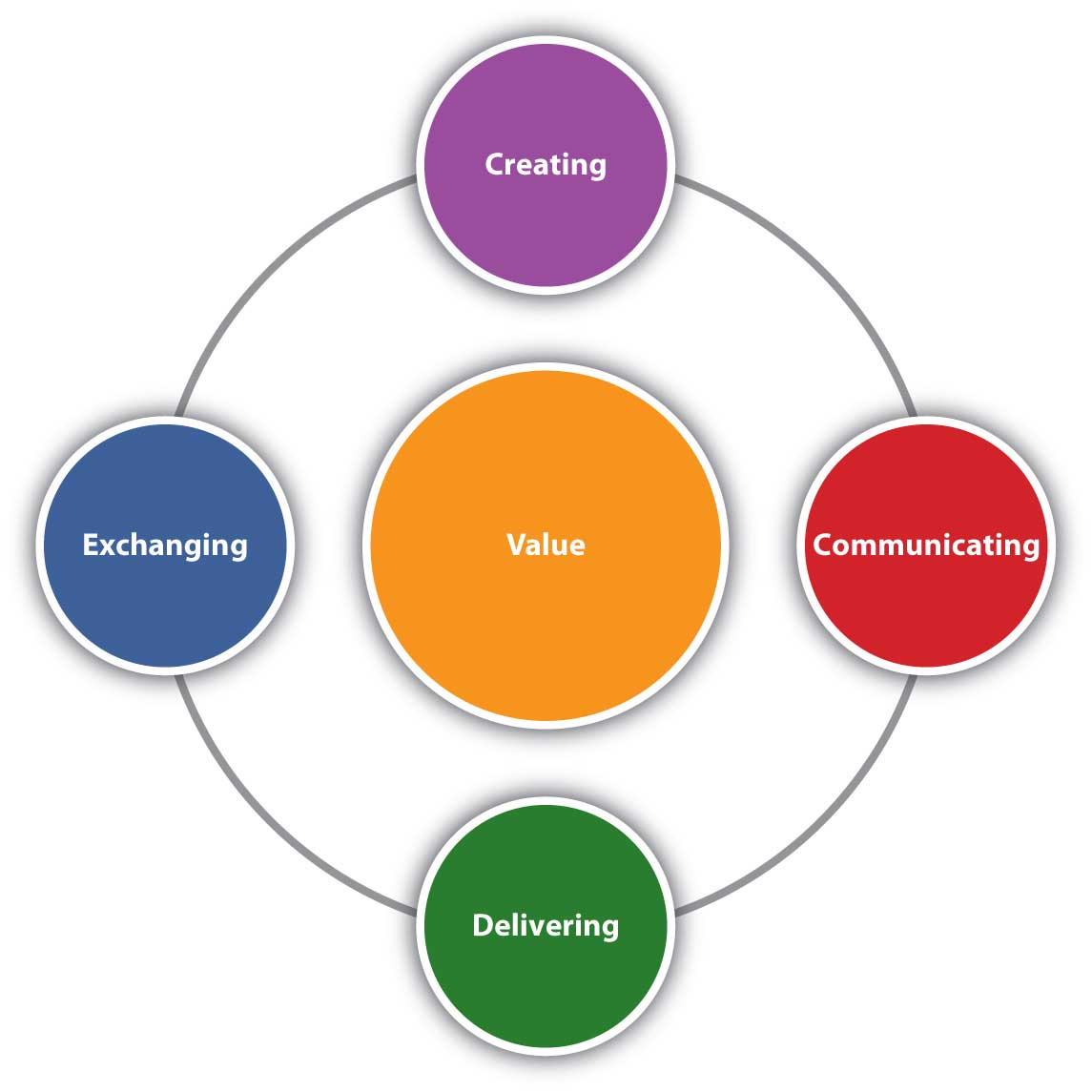
For companies who are used to sales led growth, hid the price and sale the product by relationships is a norm. In contrast, PLG give prospects a clear plan and also incentive them to upgrade by provide them a good value guidance. In the book, Wes show us how to treat your pricing and customer acquisition model right.
-
Don’t overcomplicate your pricing page Follow the
five-second test, to see if users could understand which plan is right for them almost immediately, otherwise your plan may be overcomplicated. About the best practice of how to make a price plan, here is a perfect article which the author elaborate in 20 aspects, like theSimplify the Design,Make the Copy Easy to Understand,Address the FUDs(Fear, Uncertainty and Doubt.)etc. -
Don’t create a free plan with no incentive to upgrade
You are not running a charity, where to draw the line, this could be a tough balance. Offering a key feature for free makes your customer acquisition model more powerful, but you’ll drain resources , too. Make your decision based on your key value metrics data monitoring. -
Don’t make it a no-brainer for the majority of your customers to downgrade There’s no way to avoid this entirely, but you can minimize risk. Look at the number of customers who use only the tools and features you’re about to give away for free:
- How many of these paying customers would be a prime fit for your free plan?
- What percentage of these paying customers are you willing to risk losing?
- How many more users do you expect top generate by giving away this free feature?
- Is it worth it for your business to give this feature away for free?
- Does this free feature include a value metric? Still, ask yourself a key question before you make the decision about which part should give away for free, Are you willing to take a short-term dip in revenue for a long-term gain?
Four Common Pricing Strategies
-
Best-Judgement Pricing
You and your team decide your price based on what you think is reasonable. Best judgement pricing is the least effective pricing strategy because you rely on the collective experience of your team, and you make assumptions about what your buyer values and is willing to pay. But, on the other side, it’s easy to sell unprofitable products without knowing it. -
Cost-Plus Pricing
This is simple, calculate the cost of selling and delivering the product, then add a profit margin on top. But there is one point that everyone can’t just simply ignore it that the margin cost for SaaS is low while you start to supporting a new customer. So, this means you probably say goodbye to your profit potential if you use this strategy. - Competitor-Based Pricing
Find your competitor’s price and decide yours. This is simple too. Sometimes it’s works especially when you have no idea how to decide your price at very beginning when you get into a new market. But is strategy also has limitation.- First, you’re assuming that you sell to the exact same customer who has the exact same problem that you can solve with your exact same product.
- Second, you’re assuming that your competitor do the pricing research, but unfortunately, seven out of ten companies do not do their pricing research, you are banking your livelihood on someone else’s guessing game.
- Value-Based Pricing
Value-based pricing bases your price on the value you provide. You determine this by taking into account how prospects value your product. A significant benefit of value-based pricing is that you'll learn what to include in each package.
So, which pricing approach will you take? Let’s listen what does Patrick Campbell said.
Each of these pricing strategies has its place in business. If you're running a gas station,
you're probably cost-plus pricing. If you are in the ultra-competitive retail space,
pricing in line with competitors will be close to the price the market can sustain.
But in SaaS, the only viable option is value-based. You are not only give customers
what they want, but you'll also be able to attract and retain these customers better.
- CEO if ProfitWell
How to Determine Your Price
Most businesses whip up a new pricing model in a spreadsheet without talking to a single customer. To avoid bombing with your new pricing model, break down your customer’s perceived value across the three core outcomes your product solves for functional, emotional, and social.
- Option1: Pricing Economic Value Analysis
-
Functional Outcome: The core tasks that customers want to get done. Usually can break down into factors such as incremental revenue, reduced cost, reduced risk or time saving. For example, your product could help your customer save 1 formal employees whose salary(Include Provident fund) is $8000/month, and also could reduce the time of generating the final report from 1 week to 1 day. Then your product price should not be less than $9600/year at least (10X rules: Provide customer 10X value).
-
Emotional Outcome: How customers want to feel, or avoid feeling - as a result of executing the core functional job, for example, you can tell your customer that you no longer need to hire a full time employee to crunch the number for almost a week to get the final report every quarter, what you just needed is get the report automatically in the product and use another day to refine the report, then everything done. What do you think how much would this customer pay for your product? I think maybe he could agree for $9600/year or $11000/year. Emotions play a key role in our decision-making process both online and offline and in order to truly grow your business you have to start understanding your customers and their decision-making process better.
-
Social Outcome: How customers want to be perceived by others, maybe your product could make your customers feel like a “professional” during a presentation or make him or her promoted after using your product. Your customers like share the report with your logo, recommend it his colleagues or teammates. All of these are social outcome that your product could provide to your user.
-
Basing your pricing on market and customer research is one of the best ways to understand how much your customer is willing to pay for your product or services. In the book, the author call it Van Westendorp Price Sensitivity Meter. Finding an acceptable price range is especially important to avoid we set our price too high to lose the majority of sales or too low to lose out the majority of profits.
- Option2: Market and Customer Research
- Prepare Question to Ask
- Too Expensive: At what price point would you consider our product tobe so expensive that you would not consider buying it?
- Expensive: At what price point would you consider our product so expensive that you would give it some thought before buying?
- Bargain: At what price point would you consider our product to be a great deal for the money?
- Too Cheap: At what price point would you consider our product so inexpensive that you would feel the quality couldn’t be excellent?
- How to Ask
- Survey tools
- Interviews

- Crunch the Numbers Once you know your PMC(Point of Marginal Cheapness) and PME(Point of Marginal Expensiveness), you’ve found your acceptable price range: the space between bothy points.
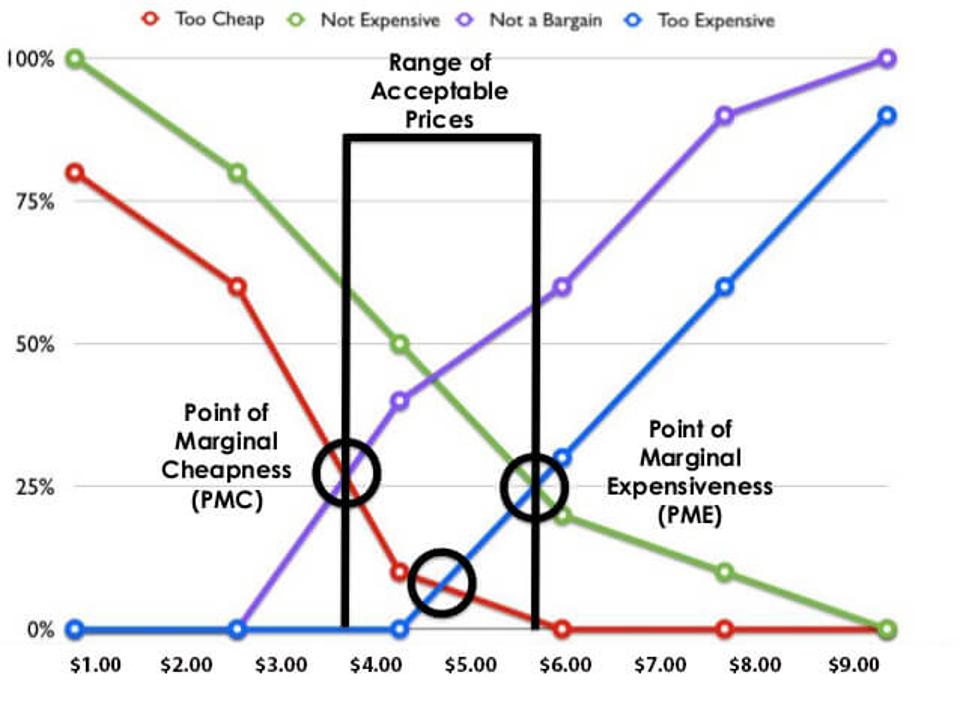
As the product evolves, you would better do the price research at a specific interval.
- Prepare Question to Ask
What Should You Put on Your Pricing Page?
- Value Metric (Please refer to Understand Your Value)
- Willingness to pay for all packages
- Valued features
- Leaders: “are the hamburger in your McDonald’s value meal; they are what everyone wants and comes to you to buy. These must be included in all packages”
- Fillers: “are the fries and coke. They are seen as nice-to-have and sweeten the deal. Customers will cherry-pick fillers when sold à la carte, and so a bundle helps drive uptake and a higher average revenue per user”
- Bundle killers: “are the coffee of your value meal. Few people want a value meal with a burger, fries, coke and a coffee, and adding coffee to the value meal might even turn people off from buying entirely because they’d end up with more than they need.”
- Demographic Information
- It allows your audience to self-segment quicker
- It helps you prioritize the features and benefits that are most valuable to the target audience
Some examples:
Deliver On Your Value
What we promise in our marketing and sales is the perfeived value, What we deliver in our product ios the experienced value. Ideally, the perceived value align with the experienced value.But, most companies struggle with over-promising and under-delivering. The bigger your value gap, the leakier your funnel. 40%-60% of users who sign up for your product will use it once and never come back.
From the blog The Value Gap Problem Most Companies Have & How to Fix It, the author give us a clear definition for value gap and also point out 4 major symptoms:
- Campaigns are not performing or under-performing.
- Conversion rates are low.
- Churn rate is high.
- Problems growing user base.
Also, the author tell us about How to Identify a Company’s Value Gap Problem
Step 1: Step Back and Take a Look Ask yourself the following questions,
- How is my positioning?
- Does my positioning give the wrong expectations to my users?
- Is my copy clear?
- Am I underestimating my product?
- Am I underselling my product?
- Is my product now being used for something other than it was initially intended?
- Should you reposition your product to adopt a new segment?
Step 2: Fresh Users Vs. Power Users A Fresh User has no experience with the product or has experienced it for a short time–under 10 minutes, A Power User is a user who has adopted and retained a product. The exact way a Power User uses your product will vary. For instance, some companies will have Power Users that adopt different uses for a product. Others may have extreme brand loyalty, use your products for their needs, and then use online platforms to comment about your products and connect with other users.
There are three main reasons why value gaps are so prominent in the SaaS industry:
- Your product has serious ability debt.
Ability debt is the price you payu every time your user fails to accomplish a key outcome in your product. To chip away at your ability debt, you need to be ruthless about reducing friction, Even non-trivial steps like activation emails can crater your free-to-paid conversion rate. Try everything you could to let your fresh user accomplish the key outcome at least for 1 time.
When you first launch a free trial or freemium model, you will inevitably have some serve ability debt. It’s expected, however, to improve your experience, you continuously need to look for ways to improve. Ask yourself these questions while going through your product experience:- Does the first product experience lead to a specific, relevant, meaningful “quick win”?
- Do tooltips and hotspots spur meaningful action in the product, not just point at buttons?
- Do social and directional cues indicate high-value behaviors?
- Are key task completions indicated with a success state?
- Are all unnecessary points of friction and distraction removed from critical workflows?
-
You don’t understand why your customers buy.
If you don’t know where someone wants to go, you can’t help them get there. When it comes to onboarding, most businesses walk you through the entire product but bring you no closer to achieving a meaningful outcome in the product. That isn’t too different than inviting your friends over to your house for dinner and, when they show up, you show them around the house but forget to give them anything to eat. This may sound straightforward, but many businesses don’t know the main outcome that people want to achieve in their product. - You over-promise what the solution is capable of.
Deliver the value need teamwork
There is another major point we can’t just ignore is that PLG is not just a plan, it needs you to convince many key stack holders to make it happen. For instance, you wanted to optimize company’s free-trial sign-up page by reducing the number of required form fields, but the sales team demanded that they keep all ten fields, It took you three months to convience the sales director to reduce the number of fields. There’s nothing more disappointing than this, right? Also, launching a free trial or freemium model requires development time, and not finish yet, you still need to sell your product and sales team on why a free trial will help them grow.
Last but not least, even if you do a terrible job understanding and communicating your value , there’s one thing you can do that will keep your business running smoothly: Deliver on your value.
Common Mistakes For PLG
Most common mistakes for PLG is Nobody Take the Ownership Note that the biggest bottlenecks to optimizing your product-led model have nothing to do with your product - it all comes down to having the right team and process in place. Before you start to build your tiger team, try to figure out where you can find the right person. There are three ways:
-
Trial and error
This option can work if you’re self-funded, but it can take a long time to build a high-converting product-led model, and the likelihood of switching back to “the old way” of doing things (SLG only model) is high. -
Hire the dream team
This option can work if the stakes are high and you don’t have enough time, however, it has downsides. You will spend lots of time recruiting, training, and getting your new team up to speed. Finding people with relevant experience is hard. -
Train your team
This option is the fastest way to get your product-led model up and running. Your current employees are already familiar with your product, know the customers and want to see your customers succeed. This option is highly recommended. In yourtiger team, you need these seven roles work together:- Developer
- User Experience Designer
- Product Manager
- Customer Success Rep
- Digital Marketer/Inside Sales
- CEO
- CPO or CTO
This tiger team is eventually responsible for building out their own mini-team within your company, so choose carefully.
Speedup Your Business
Optimization Process
By saying optimization process in PLG, what you need to do may follow the Triple A process:
- Analyze
Arrange a recurring calendar notification for this part, involve your tiger team together, analyze the major input and outputs. The input and output could be macro and micro ways.- For macro metrics it like follows:
- Number of signups
- Number of upgrades
- ARPU (Average Revenue Per User)
- Customer Churn
- ARR (Annual Recurring Revenue)
- MRR (Monthly Recurring Revenue)
- For then other side, micro metrics could be your north star metrics, such as:
- Number of searches
- Number detail views
- Number of video watch
- Number of connection
- etc. etc. etc.
- For macro metrics it like follows:
- Ask
To optimize any business, you need to ask three questions:-
Where do you want to go?
Ask yourself what’s your clear goal, the goal could be $6 million ARR, or 100,000 sign up etc. Never stop asking you this question, you should adjust your goal once you hit it, and also, remember that get your business closer to your goal. - Which levers can you pull to get there?
It’s the same when it comes to your business. According to Jay Abraham’s multiplier theory, there are three levers you can pull for SaaS growth:- Churn
- ARPU
- Number of customers
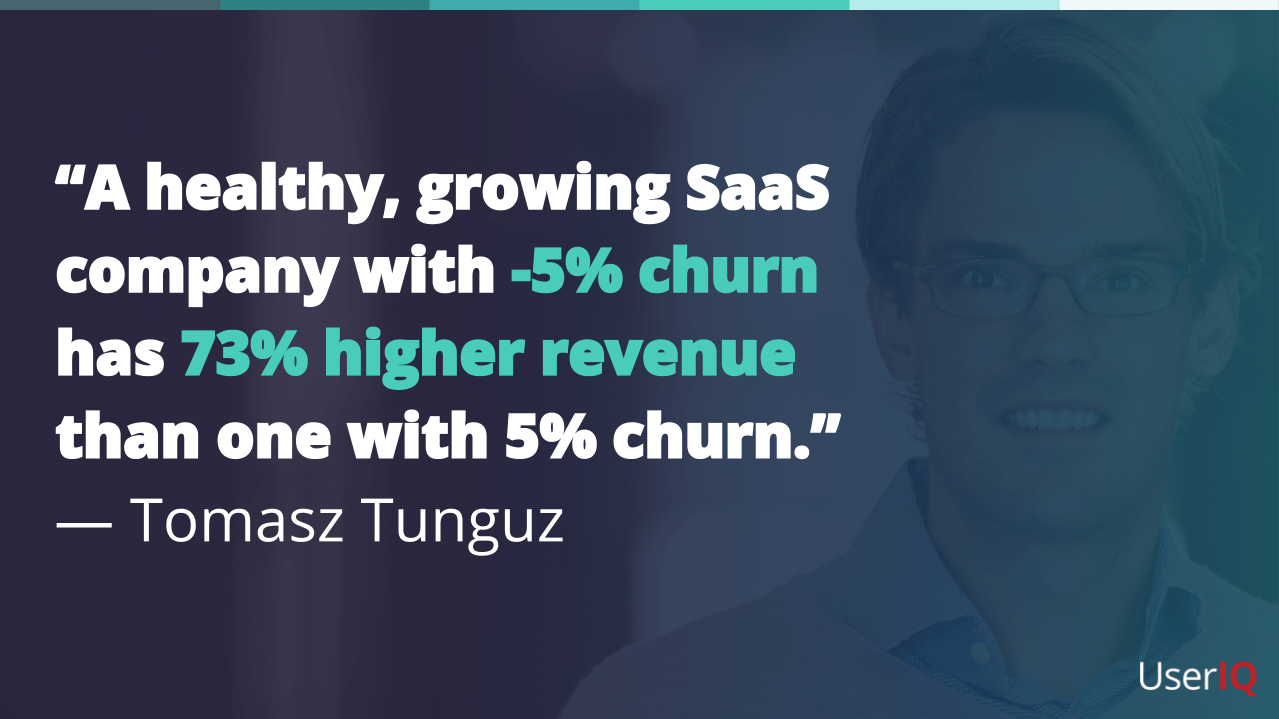
Drew Sanocki, former CMO at Teamwork, found that decreasing his churn rate by 30%, increasing ARPU by 30%, and increasing total customers by only 30% increased lifetime value (LTV) by over 100%. Breaking down your business by these three levers lets you quickly identify which ones will help your business grow fastest. Unless you’re just starting out, reducing churn and increasing ARPU will almost always have the biggest impact. Once you nail your churn and ARPU, you can start multiplying your business with each additional customer.
Take the example from my own, what we have done was just starting a brand-new product pharmsnap.zhihuiya.com in China (Which is synapse.patsnap.com for global), the product is at very beginning, the macro metrics we always take to crunch is the number of sign up and the north star index for micro metrics.
- Which inputs should we invest in?
Follow the UCD framework, using ICE to keep improving your product. TheICEstand for:- Impact: How big of an impact could this input hav on an output I want to improve
- Confidence: How confident am I that this input will improve my output metrics?
- Ease: How easy is it to implement?
-
- Act
From taking baby steps to take bigger swings that require more resources and time. Tracking the outcomes and quickly adjust your roadmap and actions. Here are high-level process that worked for author’s growth team, it’s also almost the same way our team is doing:- Get wins on the board to build with leadership and other teams, such as product and engineering
- Prioritize growth experiments you can execute quickly to demonstrate results
- Once you start to see a high-level of test failures oir non-results, move on to tackle more complex growth opportunities (take big swings)
- Eventually, tell your CEO you want to test pricing (take even bigger swings)
Bowling Alley Framework
The Bowling Alley Framework is a powerful onboarding strategy. It’s quite like the Bumper Bowling which has bumper on both side to prevent the ball from getting into the gutter. **When user get sidetracked or leave the product, it’s our duty to bump them back in the right direction. To master the Bowling Alley Framework, you need to do three things:
- Develop your straight line
A straight line is the shortest distance to get from Point A to Point B. Unlike a sales-led organization, in which the goal is to take people from Point A tro Point B in a sales cycle, we want to take people from PointA to Point B in their lives, THis is done byu letting users try before they buy and doing everything we can to help them experience the value of our product. There also three major things we could do:-
Mapping out the path
In order to check your every step in your freemium or free-trial, you need to map your steps, then you can try to make the product easy to use and remove every unnecessary steps. In the book, the author give us an example, if you are established e-commerce business, and you have several Amazon and eBay stores. You need a product help you to manage all the stores, but after you start using this product, you found you need to integrate with your eBay and Amazon account and stores in around 50 steps. This isn’t easy for customer. So, take a screenshot for every step, then star to label them. - Labeling every checkpoint
- Green is absolutely necessary
- Yellow is for advanced features that can be introduced later
- Red can be removed completely
- Developing your straight line
Make the decision, try to simplify your path and make it straightforward. Take the example above, integrate with Amazon account is green, but setup customer signature could be an better to have option at very beginning, it could be yellow, then fulfill your nickname is absolutely red, it can be asked to complete while user make sharing or make some customization progress.
-
- Create a product bumper
Product bumper are mission critical, They help users adopt the product within the application itself. Common product bumpers:- Welcome Messages
- Welcome messages are your opportunity to greet new users and make them feel invited
- In addition to saying hello, use them as an opportunity to restate your value proposition
- Welcome message can also set expectations for what users will experience with your product
- Product Tours
- Product tours should as users what they’re trying to accomplish in the product
- Product tours should cover important steps that set users up for success with the product
- High-performing product tours ofer use a focus mode that strips away unnecessary elements
- Product tours are typically between three and five steps
- Progress Bars
- Effective progress bars start with a substantial percentage of the bar already filled
- Checklists
- Checklists can motivate new users to complete crucial set-up tasks
- Checklists can turn complex, multi-step processes into simple, achievable tasks
- Onboarding checklists employ the Endowed Progress and Zeigarnik Effect
- Endowed Progress
If you provide some type of artificial advancement toward a goal, a person will be more motivated to complete the goal - Zeigarnik Effect
Basically, not finishing a task or tying up loose ends can be really bothersome, nagging at us until we complete it. Researchers call this task tension. It’s that nagging feeling that helps someone stay the course until they’ve achieved the goal and can relieve that tension
- Endowed Progress
- Onboarding Tooltips
- Use onboarding tooltips to guide users toward experiencing meaningful value in the product
- People do not use software because they have tons of spare time and love to click buttons
- Empty States
- Empty states are useful for when a user first lands on a product’s dashboard
- Empty states should prompt users to take an action that will lead them closer to experiencing meaningful value in the product
- Welcome Messages
- Build a conversational bumper
Conversational bumpers work to educate users, bring them back into the application, and eventually upgrade their account. Common product bumpers:- User Onboarding Emails
- Welcome Emails
- Usage Tips
- Usage-tip emails nudge users to take steps in the product that set them up for success
- The best usage tops are trigger-based and sent out once you do or don’t complete an onboarding task
- Sales Touches
- The sweet spot for spending sales-touch emails is as soon as someone experiences meaningful value ion your product
- Craft sales-touch emails to help users get more value out of the platform
- Case Study
- Use cas-study emails to combat objections that users might have before they enter the buying phase
- Make sure that each case-study email answers “What’s in it for me?” for users
- Better Life
- Better-life emails showcase the benefits of your product
- The call to action can ask users to upgrade or help users experience product benefits for themselves
- Post-Trail Survey
- Too expensive -> Provide a one-time discount
- Went with another solution -> Send top-of-funnel lead-nurturing emails to stay top-of-mind if the other service doesn’t work out
- Just doing research -> Add to nurture
- Missing product feature or integration -> See if it’s in your product roadmap; if so, let them know whe it’s alive
- Expiry Warning/Trail Extension
- You must send expiry emails if you have an opt-out free trial. If you don’t, users will forget they signed up and get amd when they get charged for product they haven’t been using
- Restate your value proposition in each expiry email to create a compelling reason for users to upgrade
- Make it incredibly easy for someone to upgrade in the expiry email
- Push Notifications
- Explainer Videos
- Direct Email
- User Onboarding Emails
Increase ARPU
On average, a reperat customer will spend 67% more trhan a new customer. You don't have
to be a financial whiz to figure out that an easy, profitable way to grow your business
is to sell to existing customers.
- Joel Yok
ARPU is a metric that stands for average revenue per user. In short, it’s the average amount of revenue generated by each active user of your app over a given period of time. While average revenue per user was originally primarily used in the telecom industry, it has become useful for all types of digital businesses, from SaaS providers to social media networks to mobile apps. (What is ARPU)
How to Define a User
In B2B, the word “account” can be synonymous with user, even though an account might have multiple users. Or, if you have a freemium model, only paying users would qualify as “users” when calculation ARPU
How to Calculate ARPU
ARPU is calculated by dividing your revenue by your number of users over the time period you want to measure, such as a week, month, or year. Average revenue per user is most commonly measured on a monthly level, using monthly recurring revenue (MRR) as an input.
ARPU = Toal MRR / Total Users
For example:
- You have $100,000 MRR
- Right now, you have 5,000 customers
- Your ARPU is $100,000 / 5,000 = $20
Why Should You Care about ARPU
- How to market your business
- If direct sales makes sense
- Who your most profitable customers are
For different ARPU level, the actions for you also could be different. If you have a low ARPU, you might want to consider SEO, paid marketing channels might be too expensive. Or, if you have an extremely high ARPU, you can consider hiring an enterprise sales team.

Knowing your ARPU will also help you figure out which customers are a good fit. Not all customers are created equal. Companies with a “grow at all costs” mentality die hard.
How Do You Optimize for ARPU
-
Use Value Metrics
Find a balance between set the pricing too high to lose users and give away the majority of your features for free. -
Improve Your Pricing Tiers
Remove unneed pricing plan, the more choices you have, the less likely you are to choose. Limit pricing options to three or fewer and highlight the most popular plan. - Raise Your Prices
-
Treat Your Best Users Like the Queen
With an ideal buyer journey, you can generate 80% of your revenue by focusing on 20% of your best leads. - Upselling and Cross-selling
For upselling, if you use value metrics in your pricing model, you’ll naturally be able to charge more as customers grow and get more value out of your product. However, you can also upsell via add-ons and services that help customers kick ass at whatever you help them do.
Decrease Churn
Much like it's more exciting to buy a new car that to maintain a current vehicle, it's
a lot easier to celebrate new customers than retain customers.
- Wes Bush
What is Churn Customer churn is the percentage of your customers or subscribers who cancel or don’t renew their SaaS subscription during a given time period. For example,
- You have 100 customers at the start of the year
- 10 of them cancel by year’s end
- Your churn rate is 10/100 = 0.10, or 10% customer churn
A holistic approach measures churn in three ways:
- Customer Churn: The number of customers lost in a given time period
- Revenue Churn: The amount of revenue lost in given time period
- Activity Churn: The number of users at risk of churning due to red-flag activity(e.g. not logging into the application for 1 month etc.)
How to Calculate Churn
- Customer Churn
Customer Churn = (Churned Customers)/Total Customers)×100 Based on Kimmel’s research, here are some of the average churn rates you can expect.

- Revenue Churn
Revenue Churn = (Churned MRR)/Total MRR)×100
Here’s a hypothetical situation:- You have1% customer churn and 100 customers.
- However, the one customer you lost accounted for $40,000 MRR
- If your total MRR was $100,000, your revenue churn is 40,000/100,000 = 0.4, or 40%
- Activity Churn
If a user hasn’t used your product in siz months, they’re at risk of churning. There is no simple formula for activity churn, formula is unique for different product. But you can start to measuring them from some steps as below:
- Define Engagement for Your Product
Like micro metrics mentioned before, these could be
- Numbers of search
- Number of detail view
- Number of created email alert
- Number of added photo
- Number of sharing
- etc. etc. etc.
-
Start Tracking These Product Activities Prepare it before you launch your product or release your new features, and keep tracking them by using the tools or by analyzing the logs
-
Weight Each “Engagement” Event Not all activity is created equal, weight them between 1-10
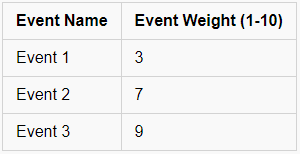


-
Give It Context by Normalizing Raw Scores 458 is good or bad? This is not meaningful then you need to normalized them into 1-100. Use Winsorizing plus with exponential function formula is a good choice.
- Apply the Scores to Make Them Actionable
- Rank Your Users
- Discover your power user and find out what makes them great
- Prioritize customer-success efforts to drive great support, identify problem users, and spot growth opportunities
- Drive more personalized marketing programs
- Identify great user research targets
- Score and Rank Your Accounts
-
Calculate the Overall Score for Your Product By calculating a score for each one of your users, you can also aggregate those scores to create an engagement score for your product as a whole.
- Compare Populations or Cohorts
- Correlate with Other Business Metrics
- Rank Your Users
- Define Engagement for Your Product
Like micro metrics mentioned before, these could be
Summary
PLG is not a silver bullet for sure. If you are running an SLG product and try to turn it into PLG + SLG model, or you are just running a brand-new product and try to acquire your first group of users, and may be keep finding your power users as well. PLG is a great idea for you. Whatever freemium, free-trial or demo, you need to take the actions by yourself and keep adjusting the goal, keep crunching the number, and most importantly is keep asking yourself if your product delivers the value to your customers?
Reference:
https://productled.com/book/
https://openviewpartners.com/product-led-growth-index/
https://discovery.patsnap.com/company-profile/3f42425756771203cd954c2386d8efdc/investment
https://www.techadvisor.com/buying-advice/entertainment/best-streaming-service-3668647/
https://www.canva.com/
https://www.launch-marketing.com/red-vs-blue-ocean-strategies/
https://www.cleverism.com/top-vs-bottom-selling-strategies-best-business
https://openviewpartners.com/blog/why-do-saas-companies-still-charge-by-the-user/
https://courses.lumenlearning.com/waymakerintrobusinessxmasterfall2016/chapter/reading-defining-marketing/
https://optinmonster.com/pricing-page-best-practices/
https://www.inc.com/eric-holtzclaw/selling-fud-redefined.html
https://www.forbes.com/sites/rebeccasadwick/2020/06/22/how-to-price-products/?sh=304158de55c7
https://baremetrics.com/blog/marginal-cost-why-you-need-to-know-it
https://www.priceintelligently.com/blog/bid/195287/the-value-metric-optimize-your-pricing-strategy-for-high-growth
https://www.canva.com/pricing/
https://www.smartsheet.com/pricing
https://www.wrike.com/price-vo/
https://www.business2community.com/strategy/saas-growth-the-triple-a-sprint-framework-that-gets-results-02215370
https://saasboomi.com/the-why-what-and-how-of-product-led-growth-strategy-a-cheat-sheet/
https://www.productled.org/blog/bowling-alley-framework
https://zapier.com/blog/endowed-progress-effect/
https://www.adjust.com/glossary/arpu-definition/
https://www.salesforce.com/eu/learning-centre/sales/what-is-inside-sales/
http://briannekimmel.com/sales_assisted_growth_intro/
https://en.wikipedia.org/wiki/Winsorizing
https://en.wikipedia.org/wiki/Softmax_function#:~:text=The%20softmax%20function%2C%20also%20known,logistic%20function%20to%20multiple%20dimensions.



